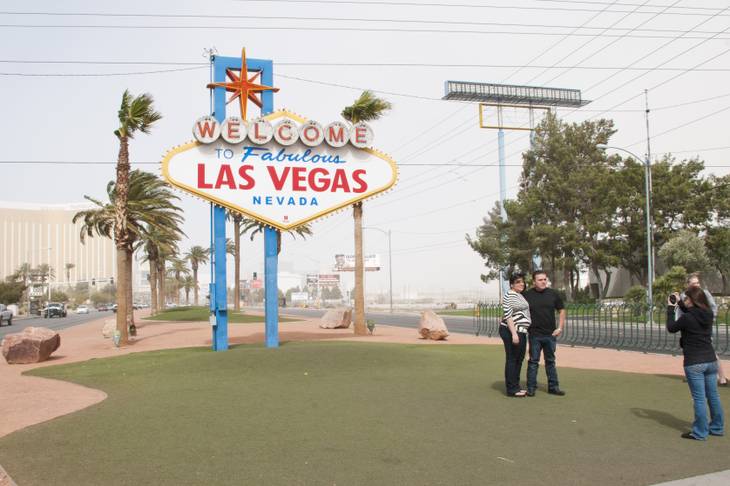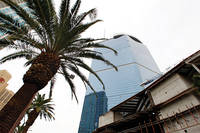As Southern Nevada fights to rebound from the recession, Las Vegas continues to spend staggering sums on advertising, marketing, promotions and public relations to maintain the city’s status as one of America’s most popular playgrounds.
So how is Las Vegas perceived by those who are the targets of the city’s promotional efforts?
Catharine Hamm, travel editor of the Los Angeles Times, offers a perspective crucial to Las Vegas: the newspaper’s Southern Californian market generated 26 percent of the 38.9 million visitors who came to Las Vegas in 2011.
“Vegas is like L.A.’s younger sister — lots of fun, not quite as experienced as L.A. but hipper in a brash way,” says Hamm, who has spent more than 12 years covering the SoCal travel industry, including nine in her current role. “For both Vegas and L.A., the good times rolled and rolled and rolled. Seven hundred dollars a night for a hotel room? Not a problem. A thousand dollars for tickets to a concert? Well, OK. Desserts with edible gold? Bring me three. And then September 2008 hit, and it all came crashing down. So like the sisters who were interested in dancing the night away, having some naughty, some nice fun, we got caught. Now we are grounded for, as my parents used to say, the rest of our lives. That was never true with my parents and I’m sure it’s not true with the traveling public, but it can feel that way. The party isn’t over in Vegas, but it doesn’t feel like as much fun when you see the Fontainebleau standing like a hulking reminder of our excesses or you walk through Crystals and see so many storefront vacancies or you can actually get a pai gow table to lower its limit on a Sunday afternoon because there’s no one in the casino. We look in Vegas’ mirror and we see L.A.”
Hamm says Los Angelinos think of Las Vegas almost as a suburb, and want to come over and play. But while many are making the trip, the key for Las Vegas to draw more comes down to the simple principle of incorporating added value into the visitor experience. The city has yet to mine that concept to its full potential, she says.
“Sometimes it feels still that Vegas has this invisible ‘Only the rich need to come here,’” Hamm says. “I’m seeing some great hotel prices, but I also am seeing some outrageous ones. I recently stayed at one of the luxury Strip hotels, and we paid $399 a night for a room that was old-fashioned — a tube TV? Really? — and worn — oil stains on the upholstery? Really? I felt cheated. And I’d say this was an isolated incident but I’d recently had almost the same experience at another upper upscale hotel where the carpeting was frayed and there were, again, spots on the upholstered furniture. The concept of yield management isn’t consumer friendly if it’s a ‘one price fits all’ strategy. If it’s a room that hasn’t been redone, why not offer it to me for $150 and lower my expectations? Or give me a free spa treatment or in-room breakfast? Make it a value. Don’t insult my pocketbook.”
Marjie Lambert, travel editor for the Miami Herald, expressed a similar sentiment.
“The many high-end restaurants and hotels, the pool cabanas and the upscale casinos have changed Las Vegas’ reputation for being affordable,” says Lambert, who has been in the newspaper business for more than 35 years and has visited all 50 U.S. states. “The table minimums have gone up significantly, as have restaurant prices, and I hear some people now say that Vegas is too pricey for them — even though the more expensive hotels have not been able to maintain their high room rates in the current economy.”
Laura Daily, a Denver-based consumer travel specialist and freelance journalist who serves as contributing editor for “AARP the Magazine” and is a past president of the Society of American Travel Writers, says it all boils down to giving Vegas visitors more bang for their buck.
“That’s a biggie these days,” Daily says. “Everyone wants to feel like they paid less than the guy next to them. Vegas needs to go beyond the high-rollers and find a way to reward repeat visitors who maybe don’t gamble — or not to the levels the casinos would like — but spend their dollars in other ways. Loyalty programs are nothing new, but they are becoming more innovative across all lines of retail. Hotel/casinos, restaurants and attractions need to get with the program as today’s consumer always expects a ‘sale’ a ‘deal’ or ‘a value add-on’ and they want to be rewarded for their loyalty to a specific business.”
Daily says Las Vegas provides chances for bargains, but they may be difficult for the average consumer to find.
“The perception is either you have to be super rich to stay in the nicest properties or you can get a great package but stay in a room that hasn’t been renovated in a decade,” she says. “Cheap is NOT a dirty word these days, but Las Vegas needs to promote itself to the middle class without coming off as cheap.”
Jay Jones, a locally based freelance journalist who has written for an array of publications — including the San Francisco Chronicle, Chicago Tribune, Vancouver (Canada) Sun and Los Angeles Times, where he currently serves as the primary travel writer covering Las Vegas — often finds himself being tapped for advice by visitors or potential visitors to the city. Such conversations have yielded telling revelations about the public’s take on Southern Nevada, with both good and bad news.
“Of course, Las Vegas has always been a hugely popular destination, but in speaking to people on airplanes and in other destinations where I’m traveling and working, there’s clearly a perception that Vegas is a less expensive place to visit now,” says Jones, a frequent traveler whose passport has been stamped in 42 countries. “I was recently in a little town in southeast Alaska and I was talking with a young woman who said she and her girlfriend were taking a girls’ getaway trip the next month because it’s so cheap.”
Jones says that in many cases, visitors who aren’t forfeiting their vacation dollars on the casino floors are forking them over in order to experience the city’s world-class dining scene.
In many cases, visitors who aren’t forfeiting their vacation dollars on the casino floors are forking them over in order to experience the city’s world-class dining scene.
“Vegas has a tremendous reputation for good restaurants and has become a destination for foodies,” Lambert says. “I’ve eaten at a number of them — Prime and Picasso at Bellagio, Aureole at Mandalay Bay, L’Atelier de Joel Robuchon among them — so I know that reputation is well deserved. But I’m a foodie, so that’s no surprise. My late husband, who was not a foodie, told people: ‘I used to come to Vegas to gamble. Now I come to eat.’”
Hamm agrees that the local restaurant scene is superlative but adds that it can be cost-prohibitive for the average visitor. One suggestion?
“Give me a great place that offers the option of small plates or a mini-tasting menu,” she says. “Tickle my taste buds and maybe I’ll come back when the economy recovers.”
International travelers, who typically stay longer and spend more than domestic travelers, represent the largest potential growth market for Las Vegas. International tourists comprised 16 percent of overall visitation in 2011 — and 29 percent of tourism spending — but Bagger says the goal is to increase the international market share visitation figure to 30 percent over the next decade. In order to achieve that objective, the LVCVA promotes Las Vegas globally with the help of 15 partner offices in 75 countries.
Domestically, Bagger says the organization takes a layered approach to advertising, buying ads across all markets, and focusing on key regions such as Los Angeles, San Diego, San Francisco, Phoenix, Dallas and Denver, in addition to promoting special “branded” events to generate excitement about the city.
“What are we doing to promote Las Vegas as a destination?” Bagger says. “The short answer is a lot.”
But is it enough?
Laura Daily, a Denver-based consumer travel specialist and freelance journalist, suggests the city can do more to promote the natural beauty of the surrounding area, as well as such outdoor activities as hiking, biking and even boating. She also identifies a marketing discrepancy she finds baffling.
“It’s no secret Baby Boomers and the World War II generation have the largest amount of time and discretionary income,” she says. “Yet I see marketing mostly to Generation X and Millenials. Nightclubs, ‘toptional’ swimming pools, rock bands, etc., that are the bait of choice. That’s overlooking what should be your strongest customer base.”

